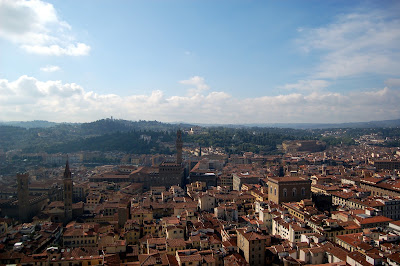The first item on our itinerary for Tuesday in Florence was to visit the Duomo. There's so much to see in the cathedral complex that we spread it out over the course of the day--first the dome climb, then after lunch, the interior of the cathedral and the ruins below. Late in the day we returned to see the baptistery and climb the bell tower.
The first thing you see amid the ever-present masses of crowds out front is the magnificent exterior.
The green, white and pink marble isn't just limited to a facade, but covers every side...
...and its detailing is amazing.
 |
| photo: flickr.com/j-stone |
Construction started in 1296 and continued for about 150 years. While we were there, lots of cleaning and restoration work was underway (in fact, we didn't even get to visit the museum, which was closed for renovations). That was a bummer, but when you see the parts they haven't yet cleaned, you realize why the work is needed:
Just inside the main church, this doorway takes you up 463 steps to the top of the cupola:
After our experience climbing the dome of St. Peter's Basilica in Rome, we were somewhat disappointed with the dome climb in Florence. Unlike St. Peter's, where the traffic in the upper section is always one-way (you never pass the people going back down), the traffic pattern at the Duomo is really poorly organized. This means people are trying to pass each other in narrow passageways like this:
Total chaos and very, very slow going. There are no posted instructions or guides to help the flow, and let's face it, people (myself included) are often thoughtless and self-centered. So this means people push forward every chance they get, not realizing that they need to STOP where it's slightly wider or else they'll fill up the only spot where people coming the other direction can pass through.
Before you get all the way up, you get to admire the interior of the dome with its 16th-century frescoes of the Last Judgment:
 |
| photo: flickr.com/anroir |
The three-dimensional feel of the paintings around the top is incredible:
And some of the scenes are profoundly disturbing:
You also get a great look at the cathedral below:
It's really mind-boggling to think this was built in the 1300s. Designed by Brunelleschi, the dome was famously constructed without a wooden support frame, using more than four million bricks.
The view at the top is impressive, to be sure. Here's what you see looking toward the Arno River:
 |
| The grassy hill in the distance is Piazzale Michelangelo |
 |
| Looking toward the Arno River, Palazzo Vecchio is just over my shoulder; Santa Croce is to the left of Steve |
Here's the bell tower, at the opposite end of the cathedral:
And here's the view in the other direction, looking toward the hills of the Tuscan countryside:
But, truth be told, if you only want to climb a lot of steps once in Florence, you should skip the Duomo. Both the campanile (bell tower) and Palazzo Vecchio are nearly as tall, and provide basically the same views--with the added bonus of a view of the dome itself (which you obviously can't get when you're standing on it). And these are both much better traffic-wise (less crowded, much more space for people to pass each other going up and coming down).
Later in the afternoon, we came back to tour the inside of the church. The interior is surprisingly sparse in comparison with the ostentatious exterior:
 |
| photo: flickr.com/Francesco Gasparetti |
Underneath the cathedral, you can tour the remains of a 5th-century basilica. Brunelleschi and others are also buried down here.
 |
| photo: flickr.com/ferrariguy |
Across from the main entrance to the cathedral, you see the octagonal Baptistery of San Giovanni, which was consecrated in 1059. Unfortunately it was mostly covered with scaffolding:
Its three sets of bronze/gilded bronze doors feature reliefs of Bible scenes. All are copies; two sets are being restored and one set is in the museum. The east door, created by Ghiberti, is called the "Gate of Paradise" (1452):
The south doors, sculpted by Pisano in the 1300s, depict the life of John the Baptist. Here's a close-up of one of the panels, John baptizing Jesus:
 |
| photo: flickr.com/Holly Hayes |
The interior dome is covered in 12th-century mosaics:
 |
| photo: flickr.com/Holly Hayes |
Later in the day, after a nap--because we had to work off all that delicious food somehow!--we climbed another 414 steps to the top of the bell tower, where we were rewarded with these views:
 |
| photo: flickr.com/emilstefanov |






















No comments:
Post a Comment